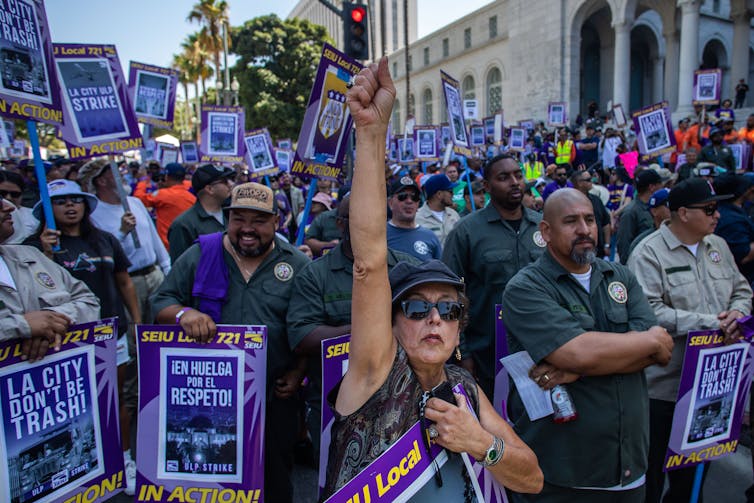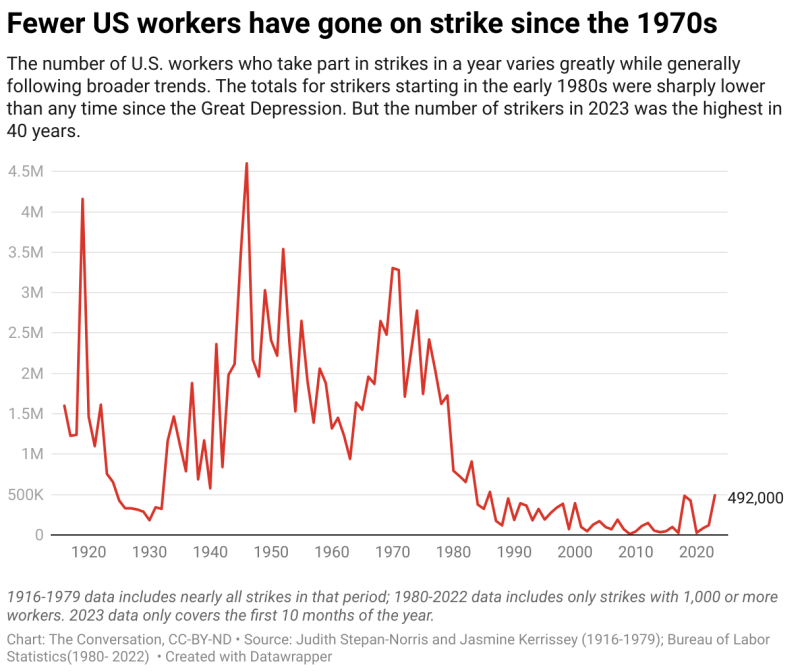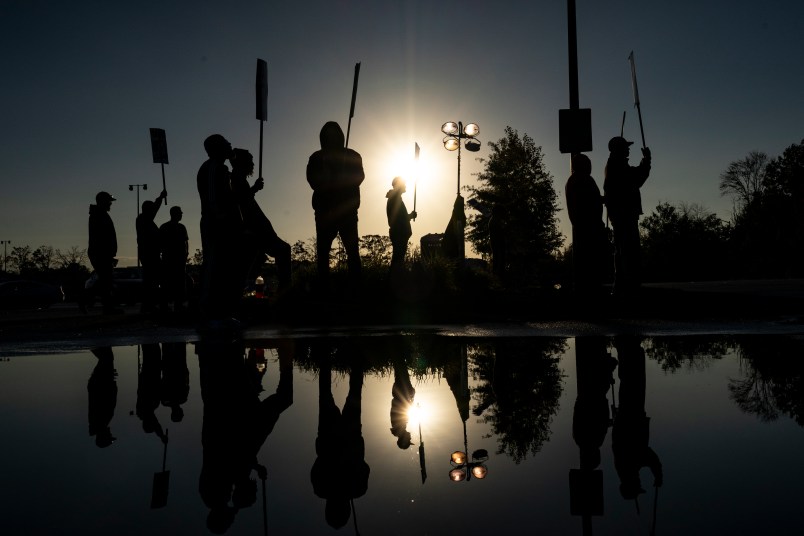This article is part of TPM Cafe, TPM’s home for opinion and news analysis. It was originally published at The Conversation.
More than 492,000 workers — including nurses, actors, screenwriters, autoworkers, hotel cleaners, teachers and restaurant servers — walked off their jobs during the first 10 months of 2023.
That includes about 46,000 autoworkers who went on strike for about six weeks, starting in mid-September. The United Auto Workers union won historic gains that have the potential to transform the industry in its contracts with General Motors, Ford and Stellantis — the company that includes Chrysler.
In addition, more than 75,000 Kaiser Permanente workers took part in the largest strike of U.S. health care workers to date.
This crescendo of labor actions follows a relative lull in U.S. strikes and a decline in union membership that began in the 1970s. Today’s strikes may seem unprecedented, especially if you’re under 50. While this wave constitutes a significant change following decades of unions’ losing ground, it’s far from unprecedented.
We’re sociologists who study the history of U.S. labor movements. In our new book, “Union Booms and Busts,” we explore the reasons for swings in the share of working Americans in unions between 1900 and 2015.
We see the rising number of strikes today as a sign that the balance of power between workers and employers, which has been tilted toward employers for nearly a half-century, is beginning to shift.

Millions on strike
The number of U.S. workers who go on strike in a given year varies greatly but generally follows broader trends. After World War II ended, through 1981, between 1 million and 4 million Americans went on strike annually. By 1990, that number had plummeted. In some years, it fell below 100,000.
Workers by that point were clearly on the defensive for several reasons.
One dramatic turning point was the showdown between President Ronald Reagan and the country’s air traffic controllers, which culminated in a 1981 strike by their union — the Professional Air Traffic Controllers Organization. Like many public workers, air traffic controllers did not have the right to strike, but they called one anyway because of safety concerns and other reasons. Reagan depicted the union as disloyal and ordered that all of PATCO’s striking members be fired. The government turned to supervisors and military controllers as their replacements and decertified the union.
That episode sent a strong message to employers that permanently replacing striking workers in certain situations would be tolerated.
There were also many court rulings and new laws that favored big business over labor rights. These included the passage of so-called right-to-work laws that provide union representation to nonunion members in union workplaces — without requiring the payment of union dues. Many conservative states, like South Dakota and Mississippi, have these laws on the books, along with states with more liberal voters — such as Wisconsin.
As union membership plunged from 34.2% of the labor force in 1945 to around 10% in 2010, workers became less likely to go on strike.
Wages kept up with productivity gains when unions were stronger than they are today. Wages increased 91.3% as productivity grew by 96.7% between 1948 and 1973. That changed once union membership began to tumble. Wages stagnated from 1973 to 2013, rising only 9.2% even as productivity grew by 74.4%.

Prime conditions
In general, strikes grow more common when economic conditions change in ways that empower workers. That’s especially true with the tight labor markets and high inflation seen in the U.S. in recent years.
When there are fewer candidates available for every open job and prices are rising, workers become bolder in their demands for higher wages and benefits.
Political and legal factors can play a role, too.
In the 1930s, President Franklin D. Roosevelt’s New Deal enhanced unions’ ability to organize. During World War II, unions agreed to a no-strike pledge — although some workers continued to go on strike.
The number of U.S. workers who went on strike peaked in 1946, a year after the war ended. Conditions were ripe for labor actions at that point for several reasons. The economy was no longer so dedicated to supplying the military, pro-union New Deal legislation was still intact and wartime strike restrictions were lifted.
In contrast, Reagan’s crushing of the PATCO strike gave employers a green light to permanently replace striking workers in situations in which doing that was legal.
Likewise, as we describe in our book, employers can take many steps to discourage strikes. But labor organizers can sometimes overcome management’s resistance with creative strategies.
New economic equations
Between 1983 and 2022, the share of U.S. workers who belonged to unions fell by half, from 20.1% to 10.1%. The COVID-19 pandemic didn’t reverse that decline, but it did change the balance of power between employers and workers in other ways.
The “great resignation,” a surge in the number of workers quitting their jobs during the pandemic, now seems to be over, or at least cooling down. The number of unemployed people for every job opening reached 4.9 in April 2020, plummeted to 0.5 in December 2021, and has remained low ever since.
Meanwhile, many workers have become more dissatisfied with their wages. The strikes by teachers that ramped up in 2018 responded to that frustration. U.S. inflation, which soared to 8% in 2022, has eroded workers’ purchasing power while company profits and economic inequality have continued to soar.
Technological breakthroughs that leave workers behind are also contributing to today’s strikes, as they did in other periods.
We’ve studied the role technology played in the printers’ strikes of the 1890s following the introduction of the linotype machine, which reduced the need for skilled workers, and the longshoremen strike of 1971, which was spurred by a drastic workforce reduction brought about by the introduction of shipping containers to transport cargo.
Those are among the precedents for the actors and screenwriters strikes of 2023, which hinged on the financial implications of streaming in film and television and artificial intelligence in the production of movies and shows.
Working conditions, including health and safety concerns and time off, have also been at the root of many recent strikes.
Health care workers, for example, are going on strike over safe staffing levels. In 2022, rail workers voted to strike over sick days and time off, but were blocked from walking off the job by a U.S. Senate vote and President Joe Biden’s signature.
Time and again, when the conditions have been right, U.S. workers have gone on strike and won. Sometimes more strikes have followed, in waves that have the potential to transform workers’ lives. But it’s still too early to know when this wave will crest.
This is an updated version of an article originally published Aug. 24, 2023, with nearly complete data for the number of strikers in 2023 and additional details about several strikes. This article is republished from The Conversation under a Creative Commons license. Read the original article.







Reagan. Ever the pig.
This is very important. Labor’s share of national productivity has been shrinking since Reagan and is still a long way from post-war levels of income distribution. Many of the distortions in our economics (boom/bust), politics and policies can be traced to that problem and by extension national priorities and law.
“When plunder becomes a way of life for a group of men in a society, over the course of time they create for themselves a legal system that authorizes it and a moral code that glorifies it.” â Frédéric Bastiat
Understated factor of strikes. While striking workers often include higher pay and benefits as a key demand, the reason they strike in the first place is often working conditions. People can (and do) regularly accept poor pay and benefits, but not working conditions that put their health or life (or the health or life of the people they are serving) in jeopardy.
Also, it was remiss of the authors to fail to note that the Biden administration did get those rail workers paid sick leave, even though he signed a bill preventing them from striking over it.
The above is how a pro-labor President acts. And Joe is the most pro-labor President since FDR, delivering progress even when he has to upset people to do so.
No mention of the impact of the baby boomers on the erosion of unions and worker pay and benefits. I don’t think it is a coincidence that pay and benefits both stopped increasing when the bulk of the baby boom generation entered the workforce. I was told more than once over the years, but especially when I was younger, that if I didn’t like the pay I could quit and let one of the people in line behind me have the job. The generation now entering the workforce is much smaller and therefore has more leverage than we had. In fact I have noted that the local convenience store pays more than I ever made as an engineer. Corporate behemoths were able, with help from our government, to keep pay scales down for most of my adult life. About time that the workers get a bit of the pie.
The two major components of the eternal conflict between capital and labor, fair compensation and safe working conditions, are both controlled by the capital side of the equation unless labor can balance the playing field with the power of an organized work force or government intervention. The Reagan administration clearly aligned government intervention on the side of capital, both with its dismantling of the ATC union and its antipathy to enforcing antitrust laws and all other forms of governmental regulation of business. The authors clearly illustrate this imbalance, noting that “Wages stagnated from 1973 to 2013, rising only 9.2% even as productivity grew by 74.4%.”
As @tindalos said above, society would benefit if we rethink the Golden Rule:
ETA:
I’m an early Baby Boomer who entered the engineering workforce in 1968 when, per the authors, “Wages kept up with productivity gains.” My starting salary with a BS and no relevant experience would be the equivalent of $88,000 today. I left the engineering world and entered the inflation resistant private practice of law in 1976, so I never felt the effects of wage stagnation from 1973 to 2013.
Regardless of my personal experience, I agree with you that it is “About time that the workers get a bit of the pie.”